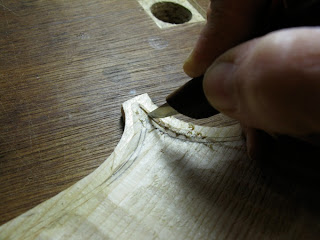 The sound holes have a lot of different roles in the balance of the sound board (the front).
The sound holes have a lot of different roles in the balance of the sound board (the front).The sound produced in the box (space between the front, the back and the ribs) is being projected via the sound holes (that are commonly called F-Holes because of the F shape of the bass one).
But wood being removed at that particular point is also playing a major hole in the flexibility of the front.
Their shape, the way they are cut, where they are placed, all plays a critical role in the sound.
They also have an esthetical purpose and to emphasize this, there is a slight fluting around the
bottom wing of each sound holes.
Our tool to cut the round holes is called an F-hole cutter. The cutter is around a axle so we have to drill a first hole that can guide the cutter through.
In doing so the angle of the arching has to be respected (we don't drill perpendicular to the ground...)
The rest of the sound hole is cut with a fret saw. The one we use for cellos is a modified one made from two fret saws.
To finish the F-hole we use razor sharp knives and it take a long time and a lot of concentration.
That way way only we can assure ourselves that elegance and harmony is respected between the two.






















